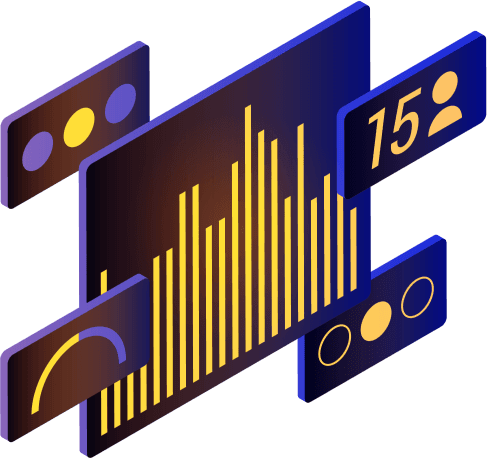Unleashing the power of IoT
The headless IoT platform giving you complete freedom to choose any IoT data source, streamlining your data into one unified API
1
Connect any of your sensors
No matter what protocol and connectivity your sensors are using we got you covered:
- We support all major protocols such as MQTT, HTTPS, UDP, GraphQL, and many more
- We support your connectivity of choice, from LoRaWAN and NBIoT to 5G
- With the complete freedom to choose what fits your use cases, you can choose the perfect setup across any of your use cases, and all your IoT data feeds into one unified and powerful GraphQL API. No more data silos.

2
Transform your data
We offer a comprehensive data transformation service that will take your raw sensor data and turn it into meaningful insights that you can use for a variety of purposes.
Our services are tailored to meet your specific needs and can be used for water measurements, waste measurements, and custom implementations. With us, you can get the data you need quickly and accurately.

3
GraphQL API to build your next application
Our state-of-the-art GraphQL API with real-time subscriptions allows you to build any application:
- Self-documenting GraphQL API allowing for full flexibility in your data queries
- Control your D4 tenant
- Receive every signal in real-time via GraphQL subscriptions
- Analyze and Aggregate your data via our Aggregation API

4
Webhooks and Smart alerts
Dimention Four provides you with smart alerts to ensure you never miss a crucial event. You can customize your webhooks to receive notifications when certain events occur and filter your alerts to only get the notifications you need.
Connect your webhook to email or sms service to make sure you never miss anything important.


Open source components
Dimention Four provides powerful, open-source components to make development easier and more efficient.
We offer a range of components for everything from charts and counters to maps and more.
Easily integrate our components into your existing framework, such as React, Angular, or directly into your website to create beautiful and informative dashboards quickly and easily.

Powerful integrations
Connect your tools and effortlessly expand their capabilities with our powerful integrations. We provide easy-to-follow documentation that guides you through the setup process and helps you get the most out of your tools. Our custom integrations help you save time and energy while ensuring maximum efficiency.

Use your data In Machine Learning
Are you looking for a way to leverage machine learning to make better decisions based on your time series data? Our service allows you to export and access your data through S3-compatible storage, so you can easily integrate it into your machine learning pipeline. With our service, you can create models to predict your usage, determine when to order supplies, and save resources.
Frequently Asked Questions
Dimension Four has a GraphQL API. What are the benefits?
GraphQL is a query language and runtime environment for APIs that provides a number of benefits over traditional REST-based APIs. Some of the key benefits of GraphQL include:
- Improved performance: GraphQL allows clients to specify exactly which data they need, so the server only sends the data that is required. This can improve the performance of the API, as it reduces the amount of data that needs to be transmitted.
- Greater flexibility: With GraphQL, clients can ask for any data they need, in any combination, using a single API endpoint. This allows for greater flexibility in how data is accessed and used.
- Stronger type safety: GraphQL uses a schema to define the data that is available through the API. This means that clients can use the schema to validate their queries and catch errors before they are sent to the server.
- Better documentation: GraphQL includes built-in documentation that describes the data that is available through the API. This can make it easier for developers to understand and use the API.
- The benefits of GraphQL can lead to improved performance, flexibility, and reliability for APIs.
What is MQTT?
MQTT is a lightweight messaging protocol that is designed for use in low-bandwidth, high-latency, or unreliable networks. It is often used in IoT (Internet of Things) and M2M (machine-to-machine) communication, where devices need to send and receive small amounts of data over a network.
MQTT uses a publish-subscribe model, in which clients can publish messages to a topic, and other clients can subscribe to that topic to receive the messages. This allows for efficient communication, as clients only receive the data that they are interested in.
MQTT also includes features that make it well-suited for use in IoT and M2M environments. For example, it has a small footprint and low overhead, making it suitable for use on devices with limited resources. It also has support for offline messaging and quality of service (QoS) levels, which can help ensure that messages are delivered reliably even in challenging network conditions. Overall, MQTT can be a useful tool for enabling efficient and reliable communication in IoT and M2M systems.
What is an API?
API is short for application programming interface. An API is a set of rules and protocols that define how different software components should interact with each other. It acts as a middleman between different applications, allowing them to share data and functionality with each other.
For example, a weather website may use an API provided by a weather forecasting service to display the current weather conditions on its website. The website would make a request to the weather forecasting service's API, passing along any necessary parameters (such as the location for which the weather is being requested), and the API would return the requested data in a format that the website can use.
APIs are commonly used to enable communication and integration between different software applications, making it possible for them to work together and share data. This can help businesses create more powerful and efficient systems by leveraging the capabilities of multiple applications.
Dimension Four is using time series database. What are the benefits?
A time series database is a type of database that is optimized for storing and analyzing time-stamped data. This data typically consists of sequences of observations or measurements taken over regular intervals of time, such as every minute or every hour.
One of the key benefits of a time series database is that it allows for efficient querying and analysis of time-based data. Because the data is stored in a structured manner, it is easy to query and aggregate data based on time intervals or other criteria. This can help organizations to better understand trends and patterns in their data, and make more informed decisions based on this information.
Another benefit of a time series database is that it is designed to handle large volumes of data, with high levels of performance and scalability. This is important, as time-based data can often be generated at high rates, and can quickly become very large. A time series database can handle this data without any degradation in performance, allowing organizations to analyze large amounts of data in real time.
Overall, a time series database can be a valuable tool for organizations looking to gain insights from time-based data. It can provide the performance and flexibility needed to effectively analyze and understand this data, and make more informed decisions based on the insights it provides.
What is UPD?
UDP (User Datagram Protocol) is a connectionless, unreliable protocol used in the Internet of Things (IoT). It is used for transferring data between devices in a network, without requiring a reliable connection or error checking. UDP is suitable for applications that require fast data transmission, such as streaming audio and video, and is often used in IoT networks to provide low-latency communication with minimal overhead.
What is payload?
Payload in IoT is the data that is sent from the IoT device to the cloud or other destination. It is typically represented by JSON or XML and usually contains sensor readings, device status information, or other relevant data.
What is LoRaWAN?
LoRaWAN is a low-power, wide-area network (LPWAN) protocol designed for use in the Internet of Things (IoT). It provides long-range, low-power communication between devices and gateways over a shared wireless spectrum. LoRaWAN is based on the LoRa physical layer modulation technology, allowing for reliable communication over long distances with low power consumption. It is used for deploying IoT applications in a variety of industries, such as smart cities, energy management, precision agriculture, and asset tracking. LoRaWAN also provides an open and secure wireless network for end-to-end secure communication between IoT devices and networks.
What is a webhook?
A webhook is an automated way for a server to send data to a client when an action occurs. It is a type of API that enables applications to communicate with one another. Webhooks allow for real-time data exchange, making them ideal for triggering events or actions when certain conditions are met. Webhooks are often used to update or sync data between two different systems, or to trigger specific actions when a certain event occurs.
Dimension Four offers an aggregation API. What are the benefits?
Aggregating data is a powerful tool for making sense of large datasets. It allows you to summarize data quickly and accurately, and to draw meaningful insights from complex datasets.
Aggregated data can be used to identify trends, measure performance, and gain a better understanding of the data. It can also help to reduce the amount of time and effort required to analyze large datasets. Additionally, aggregated data can help to reduce the risk of errors when working with complex datasets. It can also help to save time and resources, and it can help organizations to make better decisions by providing them with a more complete picture of the data.
How come you are using S3 storage in regards to Machine Learning?
Dimension Four use it because it is an ideal storage solution for machine learning (ML) applications. It offers several advantages including scalability, high availability, cost-efficiency, and security. With S3, one can store large amounts of data with ease, and access it quickly to perform ML operations. Additionally, S3 makes it easy to scale up or down depending on the ML workload and can be used to store both structured and unstructured data. It also offers flexibility in terms of access control and data security, allowing users to set up the appropriate levels of access for each user or group. Finally, S3 is cost-effective, making it a great choice for ML applications that require large amounts of data storage.
What is raw sensor data?
Raw sensor data is data that is collected directly from a sensor, without any processing or manipulation. It is usually in the form of a stream of values that measure a physical quantity such as temperature, light, pressure, or sound. Raw sensor data can be used to gain insights into physical phenomena and behavior, and can be used to create models or algorithms to better understand the world around us.
What are the main reasons Dimension Four advocates removing data silos
Data silos are a major drawback to organizations that are trying to collect, store, and analyze data. Silos are created when data is stored in separate databases and systems, meaning that data cannot be easily accessed or aggregated. Without data aggregation, organizations cannot gain a comprehensive view of their data. This means that insights cannot be drawn from the data, as it is not integrated and cannot be seen as a whole. Additionally, data silos can be costly as they require manual processes and extra resources to transfer data from one system to another. Furthermore, data silos can lead to data duplication and data discrepancies, which can affect the accuracy of the data. Without data aggregation, organizations are unable to take full advantage of their data, resulting in missed opportunities and potential losses.
With Dimension Four companies removes data silos and can further use Dimension Four aggregation API to get complete insight into their IoT data, with all its benefits.
As a product company, why would we use an API from another company rather than building the software our selves?
There are several reasons why you may want to choose to use an API from another company rather than building the software:
- Time and Cost: Building software can be a time-consuming and expensive process. By using an API, a product company can save time and money by leveraging the work of another company and integrating their functionality into their own product.
- Specialization: It's often the case that companies specialize in certain areas of software development. For example, a company might specialize in building a payment processing API, while another company specializes in building a messaging API. By using APIs from different companies, a product company can benefit from the specialized knowledge and expertise of each company.
- Scalability: APIs can be designed to scale very effectively, allowing a product company to handle an increasing number of users or requests without having to worry about the underlying infrastructure. This can be particularly important for product companies that expect to experience rapid growth.
- Quality and reliability: Many API providers have already invested significant resources in ensuring the quality and reliability of their APIs. By using an API from a trusted provider, a product company can be confident that the functionality will work as expected, and that any issues will be promptly addressed.
- Innovation: APIs can provide access to new functionality and data that a product company may not have the expertise or resources to develop themselves. By integrating APIs from other companies, a product company can stay ahead of the curve and offer their users cutting-edge functionality.

Reduce cost and complexity - fuel innovation, and start building products faster
Leave the data silos behind, the unnecessary complexity, the massive task of building a truly scalable IoT backend.. let Dimension Four handle it for you.